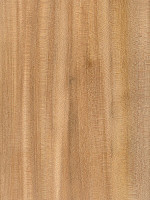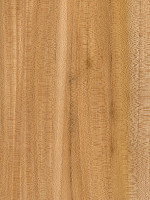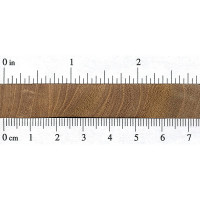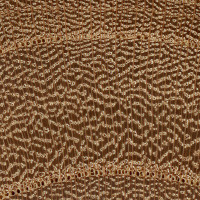 |
Common Name(s): Winged Elm, Wahoo Scientific Name: Ulmus alata Distribution: Southern and south-central United States Tree Size: 35-50 ft (11-15 m) tall, 1-2 ft (.3-.6 m) trunk diameter Average Dried Weight: 42 lbs/ft3 (675 kg/m3) Specific Gravity (Basic, 12% MC): .57, .67 Janka Hardness: 1,540 lbf (6,850 N) Modulus of Rupture: 14,800 lbf/in2 (102.1 MPa) Elastic Modulus: 1,650,000 lbf/in2 (11.38 GPa) Crushing Strength: 6,780 lbf/in2 (46.8 MPa) Shrinkage: Radial: 5.3%, Tangential: 11.6%, Volumetric: 17.7%, T/R Ratio: 2.2 |
Color/Appearance: Heartwood is light to medium reddish brown. Paler sapwood is usually well defined.
Grain/Texture: Grain is interlocked (making it very resistant to splitting). With a somewhat coarse, uneven texture.
Endgrain: Ring-porous; medium to large earlywood pores in a single discontinuous row, small latewood pores in wavy bands; tyloses occasionally present in earlywood; growth rings distinct; parenchyma vasicentric and confluent; medium rays, spacing normal.
Rot Resistance: Rated as non-durable; susceptible to insect attack. Living trees are susceptible to Dutch elm disease.
Workability: Can be a challenge to work because of interlocked grain, especially on quartersawn surfaces. Planing can cause tearout and/or fuzzy surfaces. Poor dimensional stability. Glues, stains, and finishes well. Responds well to steam bending, and holds nails and screws well.
Odor: Elm usually has a strong, unpleasant smell when green; though once dried has very little odor.
Allergies/Toxicity: Although severe reactions are quite uncommon, Elm in the Ulmus genus has been reported as a sensitizer. Usually most common reactions simply include eye and skin irritation. See the articles Wood Allergies and Toxicity and Wood Dust Safety for more information.
Pricing/Availability: Should be moderately priced, though availability from mature trees has been greatly diminished by Dutch elm disease.
Sustainability: This wood species is not listed in the CITES Appendices or on the IUCN Red List of Threatened Species.
Common Uses: Boxes, baskets, furniture, hockey sticks, veneer, wood pulp, and papermaking.
Comments: So named for its peculiar, wing-like appendages that grow on the branches of the tree. Winged Elm trees tend to be slow-growing and small, and consequently are of little commercial potential. Trees are also susceptible to Dutch elm disease.
The wood itself is hard, heavy, and strong, and anatomically Winged Elm is classified among the hard elms.







